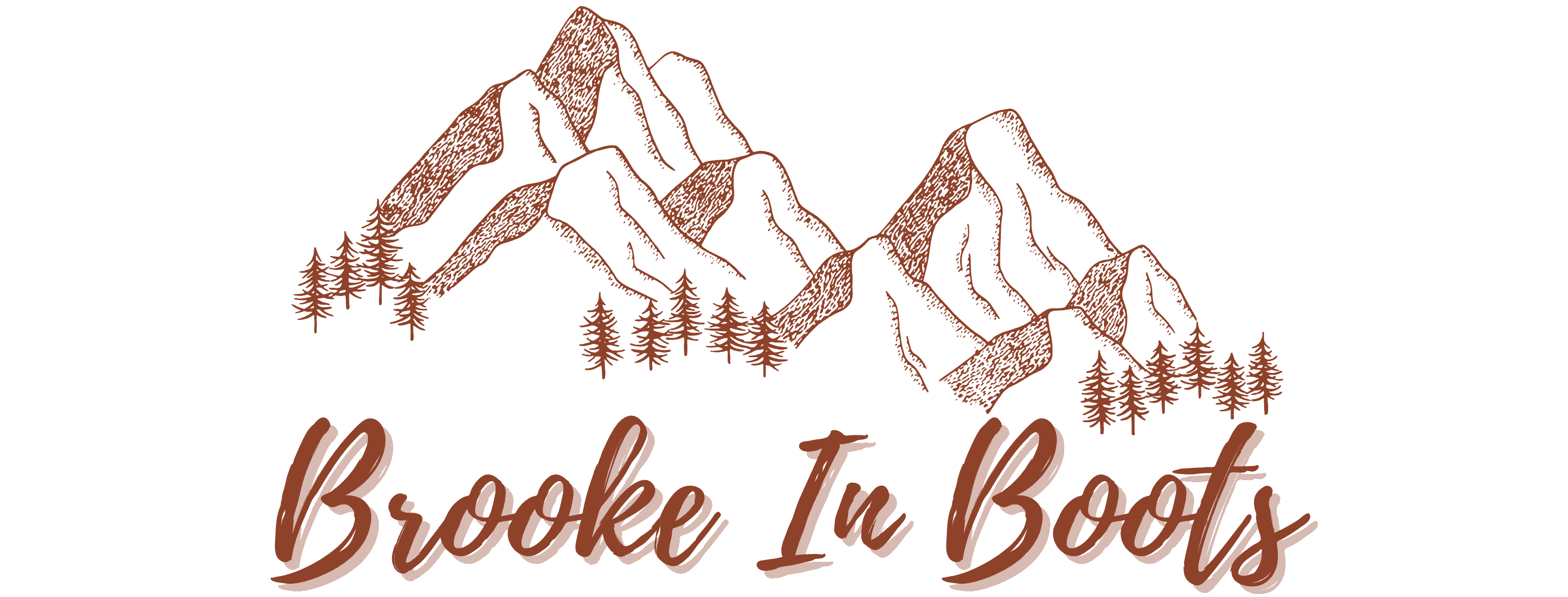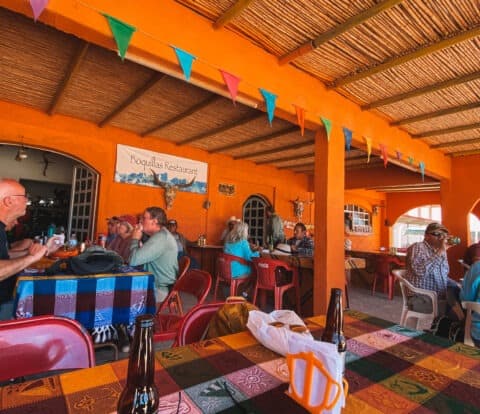
Welcome to Big Bend, an incredible landscape where the desert, river, and mountains meet to form one of the West’s best National Parks. But, like many desert Parks, the weather in Big Bend is full of extremes. From snowstorms in winter and spring to flash floods and dangerously high heat in summer, understanding the weather patterns in Big Bend can make your break your trip.
This in-depth guide includes tips on the best times to visit Big Bend National Park, seasonal and month-by-month tips for visiting incredible Big Bend.
Disclosure: This page may contain sponsored content or affiliate links, including Amazon links, where I earn a small commission from any purchase – at no extra cost to you. This commission helps keep Brooke In Boots up and running. As always, all opinions are 100% honest and my own!
A Quick Look at the Weather in Big Bend
Wondering when to plan your trip to Big Bend? Here’s a quick look at the weather you can expect in Big Bend:
- The best time to visit Big Bend are the spring months of March-April. This is also the most popular time to visit Big Bend.
- The hottest months in Big Bend are summer, in the months of June, July and August, where temperatures regularly soar into the 100s F.
- The coldest months in Big Bend are December and January. Freezing temperatures, snow, and ice and possible, especially in the Chisos Mountains region, but most days are pleasant and sunny.
- The rainy season in Big Bend lasts from July through September. Heavy rain, thunderstorms, and flash flooding are possible during this time.
What is the Best Time to Visit Big Bend National park?
If it’s your first visit to Big Bend National Park, I recommend visiting in Spring (March – April).
Thanks to the mild temperatures and low rainfall, spring is often considered the “best” time to visit Big Bend. It’s also the most crowded time to visit Big Bend, so make sure you book your lodging reservations well in advance. If you can, avoid visiting mid-March, when most kids are out of school on Spring Break.
That said, we visited Big Bend in mid-March and still had an incredible experience with very little crowds. I suggest following this Big Bend itinerary for the best chance at avoiding crowds and making the most of your trip.
During spring, temperatures range from the 30’s at night and into the 80’s and 90’s during the day. Snowstorms are unusual in spring, but can occur, so be prepared!
Check out These Posts for More Resources on Visiting Big Bend
3 Day Big Bend Itinerary Guide
Hiking Big Bend: 16 Can’t-Miss Hikes in Big Bend National Park
Driving Ross Maxwell Scenic Drive in Big Bend National Park
Best Lodging Near Big Bend National Park
How to Visit Boquillas Del Carmen Mexico from Big Bend National Park
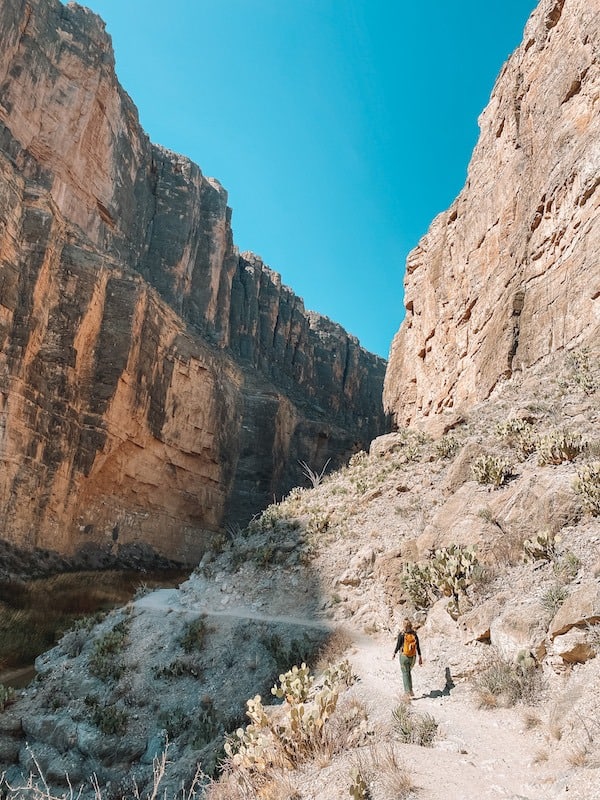
Current Weather Conditions in Big Bend National Park
You can use the following resources to check daily conditions and forecasts for Big Bend:
- NOAA Recreational Report: Provides information on weather conditions and forecasts for recreational activities in Big Bend National Park, helping visitors plan their outdoor adventures like hiking and river rafting accordingly.
- NPS Park Alerts for Big Bend: The official NPS site notifies visitors about any important alerts, closures, or updates related to Big Bend National Park. It’s a good idea to always check this page before visiting any National Park!
- Big Bend Daily Report: Offers a daily report on current conditions, including trail conditions, wildlife sightings, and other useful information for visitors to Big Bend National Park.
- Panther Junction Webcam: Provides a live webcam feed from Panther Junction in Big Bend National Park, allowing visitors to visually check the current conditions and scenery before planning their visit.
Take this info to-go! The Big Bend Itinerary Guide has your perfect 1, 2, or 3 day Big Bend trip completely planned for you! With over 20 pages of detailed hiking guides, printable daily itineraries, lodging and dining suggestions and more, you can spend less time stressing and more time making epic memories! Check it out, here.
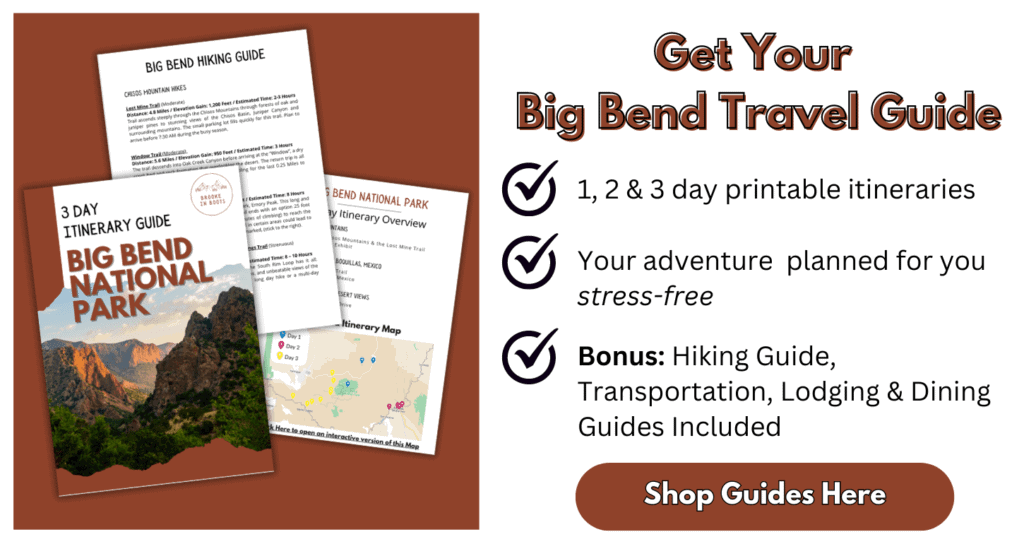

Average Temperature and Precipitation By Month in Big Bend
Big Bend is a land of extremes, and that includes elevation too!
Big Bend measures average temperature and precipitation (rain and snowfall) from the Panther Junction Park Headquarters, which sits at 3,750 feet.
Higher mountain elevations in the Park, like the Chisos Basin Campground, sit significantly higher at over 5,000 feet in elevation. While desert areas of the Park, like the Rio Grande Village Campground, lie at a mere 1,800 feet in elevation.
In the mountains, temperatures are an average of 5–10 degrees cooler during the day and 0-5 degrees cooler at night. This area also receives more rain and snowfall than average.
The desert areas of the park, however, are an entirely different experience, with temperatures averaging 10 degrees warmer during the day and 0-5 degrees warmer at night. Additionally, these lower elevation areas receive much less precipitation
Average Temperature by Month in Big Bend
This graph shows the average temperature by month in Big Bend National Park:

Average Precipitation by Month in Big Bend
This graph shows the average precipitation (rain & snow) by month in Big Bend National Park:

Want to learn more about planning an epic National Parks trip? Grab my free Ultimate National Parks Planning Guide, including 70+ pages of National Park packing checklists, planning tips, and everything you need to know to start planning a trip to all 63 National Parks!
Big Bend Weather By Season
Visiting Big Bend in Spring
If it’s your first visit to Big Bend National Park, Spring (March – April) is the perfect time to visit, and the most popular time to visit Big Bend National Park.
Thanks to the mild temperatures and low rainfall, spring is considered the “best” time to visit Big Bend. It’s also the most crowded time to visit Big Bend, so make sure you book your lodging reservations well in advance.
Mid-March, when most school children are out on “spring break” tends to be the most popular and crowded time in the Park. If you’re visiting during spring, make sure to arrive at popular spots first thing in the morning to get parking.
During spring, temperatures range from the 30’s at night and into the 80’s and 90’s during the day.
Visiting Big Bend in Summer
Summer (May, June, July, August, September) in Big Bend is long and hot. Temperatures usually spike well above 100 degrees during the day. Plan hikes for early morning, bring plenty of water, and stay OFF the trails during the afternoon!
Thunderstorms and flash floods are also common from May to September during the Park’s “rainy season.” Santa Elena Canyon Trail may be in accessible due to high water in the Rio Grande.
Hikers have died of heat-related illness in this park – don’t let it be you!

Visiting Big Bend in Fall
If you aren’t afraid of a little rain, Fall (September, October, November) makes for an excellent time to plan a Big Bend itinerary. Daytime are back in the 80’s and 90’s, and the rainy season continues through September. Visit in October for a chance to see some fall foliage in the Chisos Mountains!
Visiting Big Bend in Winter
Finally, winter (December, January, February) is mild and another excellent time to visit Big Bend National Park. Snow and freezing conditions are possible, especially in the Chisos Mountains. If you visit during winter, be prepared for all kinds of conditions, from snowstorms to sunny 70 degrees!
Take this info to-go! The Big Bend Itinerary Guide has your perfect 1, 2, or 3 day Big Bend trip completely planned for you! With over 20 pages of detailed hiking guides, printable daily itineraries, lodging and dining suggestions and more, you can spend less time stressing and more time making epic memories! Check it out, here.

Big Bend Weather By Month
If you’re planning a trip to Big Bend National Park, here’s a look at what you can expect every month.
Big Bend in January
Average High: 61.5 F
Average Low: 37.5 F
Average Precipitation: 0.69 Inches
January is a fantastic time to visit Big Bend National Park. The weather is cool but usually not chilly, although the occasional cold snap is possible. The average daytime temperatures are in the 60s and drop to the high 30s at night. But keep in mind, higher elevations of the Park, including the Chisos Mountains and Basin are usually 10 degrees colder.
Occasional snowstorms are possible, so make sure to bring plenty of warm layers and check weather and road conditions before heading out.
Big Bend in February
Average High: 67.7 F
Average Low: 41.7 F
Average Precipitation: 0.38 Inches
February is a delightful time to visit Big Bend National Park, as the winter chill begins to ease off. The average temperatures hover around a comfortable 67.7°F in the daytime, perfect for hiking and soaking in the gorgeous vistas. As the sun sets, the mercury dips to an average of 41.7°F (but colder in the mountains, remember), so having a cozy jacket on hand is still a good idea.
Depending on rain and temperatures, wildflowers can start blooming as early as February.
Snow and ice are possible, so make sure to bring plenty of warm layers and check weather and road conditions before heading out.
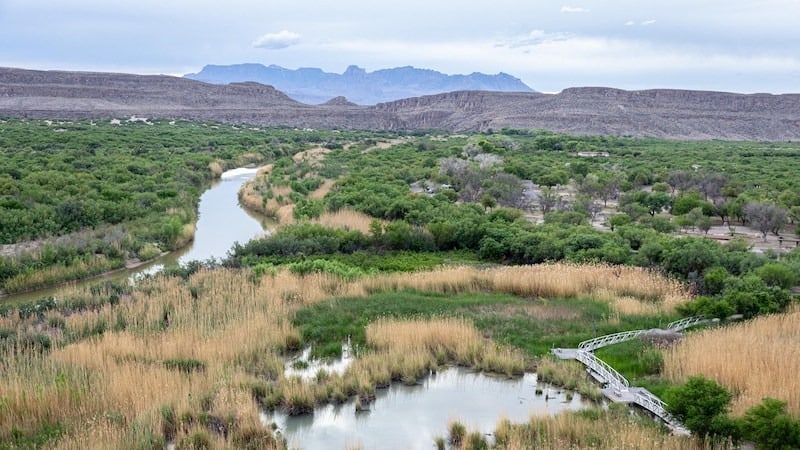
Big Bend in March
Average High: 75.2 F
Average Low: 47.9 F
Average Precipitation: 0.31 Inches
March in Big Bend is a magical time of year – and the most popular month to visit Big Bend National Park. We visited in March and the sunny skies, warm but not hot temps, and cool nights make it the ideal time for visiting this National Park.
But here’s a seasoned traveler’s tip: mid-March tends to be the busiest time in the park, thanks to Spring Break. So, if you’re after a bit of peace and tranquility, you might want to plan your trip a little before or after.
Wildflowers usually start blooming here in March and April as temperatures warm.
Don’t forget to pack layers for the fluctuating temperatures (sudden cold snaps are still possible during March) and be prepared for the rare rain shower.
Big Bend in April
Average High: 83.7 F
Average Low: 55.8 F
Average Precipitation: 0.36 Inches
Temperatures continue to climb in April, but are still comfortable enough to make this one of the best months to visit Big Bend National Park.
As night falls, the temps drops to a comfortable average 55.8°F – perfect for some stargazing at the darkest skies in the Lower 48!
Pack light layers for those unexpected cool snaps, and the rare April snowstorm.
Big Bend in May
Average High: 89 F
Average Low: 63.2 F
Average Precipitation: 1.51 Inches
Summer approaches towards the end of May, making this one of the last comfortable months to visit Big Bend before the summer heat. The average high sits at 89°F, but that number can easily reach into the 100s on the desert floor during mid-day! Plan your longer hikes early in the morning and late in the afternoon to avoid the heat, and don’t forget to bring plenty of water.
While not the official “rainy season” (that starts in July) May sees significantly more rainfall than the rest of spring, so be prepared for flash flooding and some closed trails during heavy rainfall.
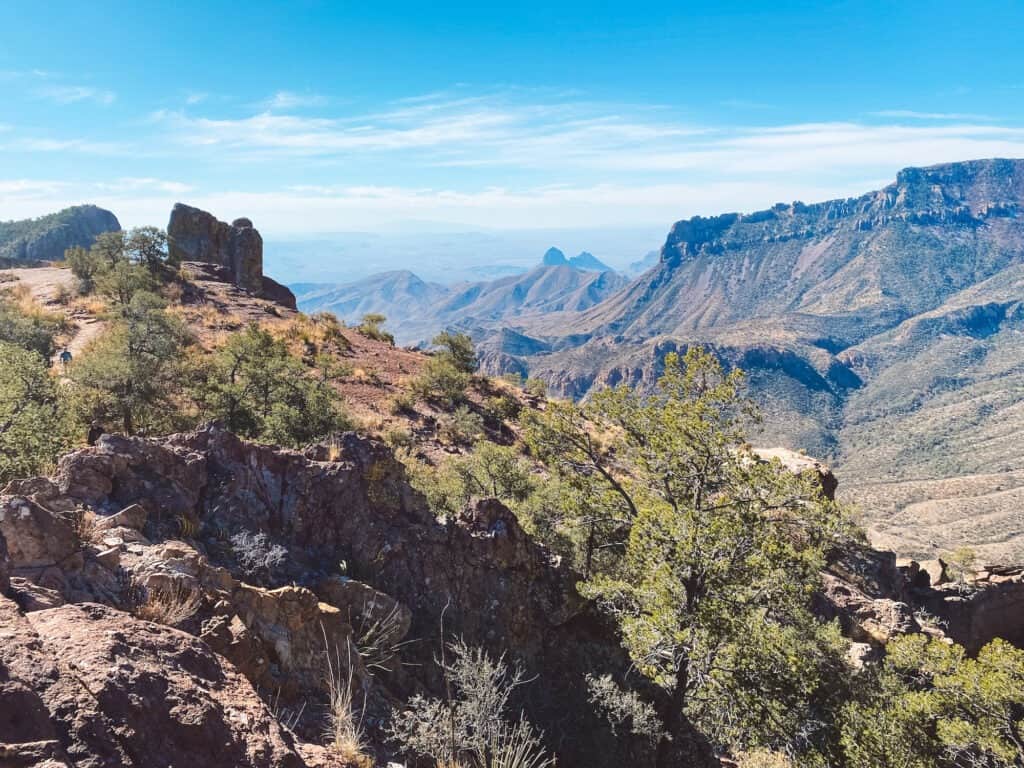
Big Bend in June
Average High: 95.2 F
Average Low: 70.3 F
Average Precipitation: 1.55 Inches
June in Big Bend National Park is the first real taste of the desert summer, and oh boy, it’s sizzling. Temperatures soar to an average high of 95.2°F, the hottest month in Big Bend, but don’t be surprised if the mercury pushes well past the 100s. Plan your hikes for early morning or late evening, and always remember to carry an ample supply of water with you.
As the rainy season nears, June sees about 1.55 inches of precipitation, which in the desert can translate to flash floods and trail wash outs, so keep an eye on the forecast and check conditions after a storm.
Big Bend in July
Average High: 92.5 F
Average Low: 71 F
Average Precipitation: 1.93 Inches
Unless you’re very experienced in desert hiking and prepared for extreme conditions, visiting Big Bend in summer isn’t really advised. Why? The park’s average high temperature in July “drops” to a “mild” 92.5°F, but don’t let that fool you – temperatures often exceed 100°F or higher! Plan your activities carefully and always be aware of the signs of heat exhaustion and dehydration.
Despite the scorching temperatures, July also marks the official start of the rainy season in Big Bend. This means that flash floods are a real possibility, so be cautious when hiking and check trail conditions before setting out. And of course, stay hydrated!
Big Bend in August
Average High: 92.2 F
Average Low: 70.7 F
Average Precipitation: 2.01 Inches
August continues to be extremely hot in Big Bend, and visiting during this time isn’t recommended unless you’re well prepared for desert conditions.
August also marks the height of Big Bend’s “rainy season”, when flash floods and thunderstorms are the most common. If you are visiting during this time, take extra precautions, and have a backup plan in case weather conditions are too hot (or too stormy) to safely continue.

Big Bend in September
Average High: 85.7 F
Average Low: 64.8 F
Average Precipitation: 1.75 Inches
September marks the end of true summer in Big Bend, as well as the end of the rainy season. Temperatures begin to cool down towards the end of the month, making it a more comfortable time to explore the park.
Be aware that flash floods can still occur during this time and it’s important to stay updated on weather forecasts. Keep in mind that temperatures still reach the high 80s or even low 100s. Plan your activities carefully and always be aware of the signs of heat exhaustion and dehydration.
Big Bend in October
Average High: 81.3 F
Average Low: 57 F
Average Precipitation: 0.66 Inches
October sees the start of reasonable hiking temperatures and lower rainfall, making it the ideal shoulder season to explore Big Bend National Park. The weather is still warm and pleasant during the day, but can get chilly at night so make sure to pack layers.
Fall foliage makes an appearance in the Chisos Mountains, adding a pop of color to the Big Bend landscape.
Big Bend in November
Average High: 70.6 F
Average Low: 46.6 F
Average Precipitation: 0.82 Inches
November brings cooler temperatures and lower visitor numbers to Big Bend than in Spring. This is a great time to explore the park without the crowds and enjoy pleasant hiking conditions.
However, be prepared for chilly nights and potential temperature fluctuations during the day. Make sure to pack warm layers and proper gear for any outdoor activities.
Fall tends to be a bit rainier than spring in Big Bend, so be prepared for the occasional shower during this month.
Big Bend in December
Average High: 63.1 F
Average Low: 39.1 F
Average Precipitation: 0.51 Inches
December is a popular time to visit Big Bend. Temperatures range into the 50s and 60s during the day, making for idea, if not chilly, hiking conditions. Make sure to bring warm layers, cold snaps and snowfall are possible during December, especially in the Chisos Mountains.
While not as popular as spring, the December tends to be a very busy time in Big Bend. Make sure to book reservations well in advance if you plan on visiting around Christmas or New Years.
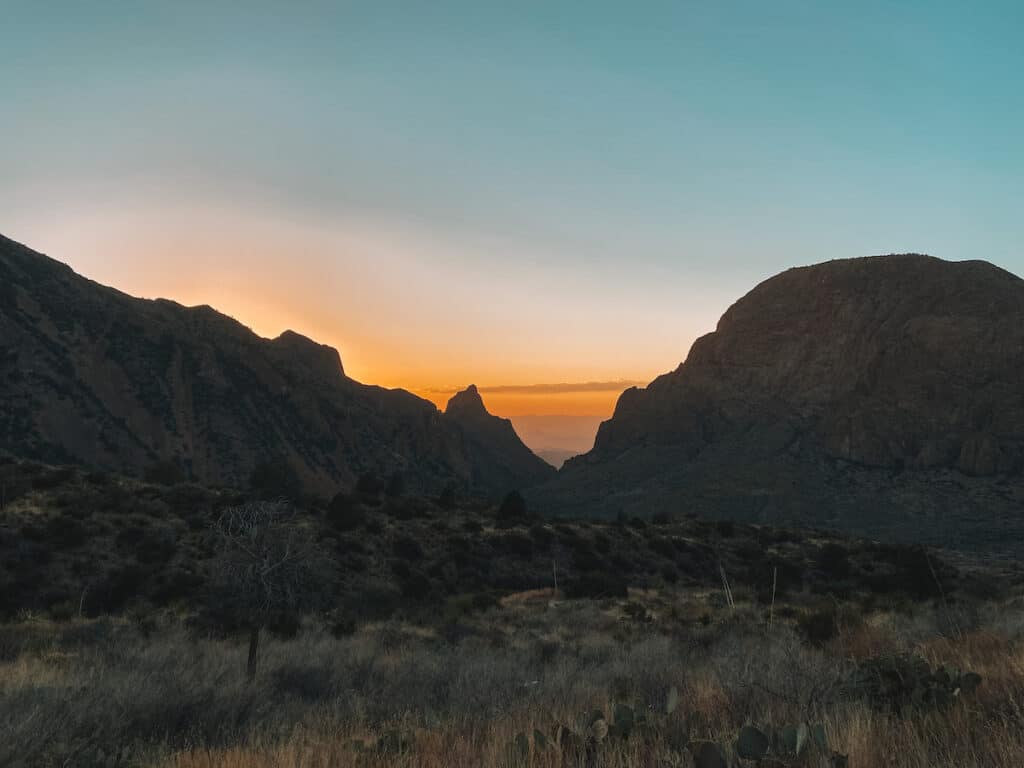
Conclusion
So there you have it – your quick guide to Big Bend’s wild weather. Remember, embracing the unexpected is part of Big Bend’s charm. Pack your layers, bring plenty of water, and come prepared for anything this amazing Park can throw at you!
Explore More National Parks
Get the Ultimate National Parks Planning Guide (for free!) sent to your inbox, full of important planning information, printable packing lists, and the best things to do in all 63 National Parks.
Big Bend: Epic Big Bend Itinerary Guide
Bryce Canyon: One Epic Day in Bryce Canyon National Park
Cuyahoga Valley: 17 Best Things to Do in Cuyahoga Valley National Park
Great Smoky Mountains: The Ultimate Great Smoky Mountains Itinerary in 2 Days
Joshua Tree: The Perfect Day Trip to Joshua Tree National Park
New River Gorge: The Best Hikes in New River Gorge National Park
Yosemite: Epic Yosemite 2 Day Itinerary – How to Spend 2 Perfect Days in Yosemite
